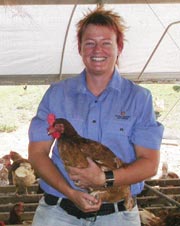The first scientific evaluation of the major causes of mortality in commercial free-range layer flocks in Australia has been completed by the Poultry CRC in conjunction with the Queensland Department of Primary Industries & Fisheries (QDPI&F) and the University of Queensland.
According to the Project Leader,QDPI&F’s Tanya Nagle, there is limited scientifically sound information on causes of mortality in free-range flocks in Australia and this project was designed to address this deficiency.
“The free-range system of egg production exposes laying hens to a wide variety of environmental conditions,” explains Tanya, “so causes of mortality are likely to be different from hens in cage systems.”
“The anticipated benefits resulting from this research will include both industry education and targeted research ideas to improve hen welfare,” says Tanya.
“These will address community concerns as well as helping to increase productivity and profitability of the free-range system.”
A survey of free-range producers in Australia was undertaken to indicate causes of mortality in the industry and to tailor the epidemiological survey to ensure temporal and locality issues were covered.
Mortality in free-range flocks can be caused by numerous factors, including feather pecking, cannibalism, disease, predators and flock management.
According to the project’s Final Report, bacterial infections affect birds on the ground more than birds in cages, which impacts on their welfare and adds to production costs in alternative systems.
Producers suffer significant economic losses because egg production drops and mortality increases. Food safety could also be compromised.
Recommendations in the Final Report include:
- typing of harmful organisms present in free-range flocks allowing specific prevention and control information to be provided to producers;
- approval of more antibiotics and anthelmintics for use in laying hens;
- an investigation into the microbial population of the oviduct in free-range, barn and cage laying hens with the possibility of developing probiotics; and
- increased producer education and improved use and availability of professionals to ensure early and correct diagnosis of causes of mortality.
Free-range is the poultry housing system most actively supported by welfare groups and represents 11% of total laying hens in Australia (1.69 million birds). Free-range eggs command a 14.5% grocery market share and are worth 23% of the value of the Australian egg industry, or $71 million a year.
For a copy of the Final Report, contact the Poultry CRC’s Communications Officer, Chris Day on (02) 6773 3767.


